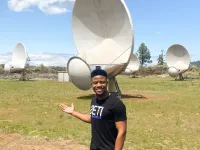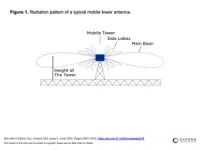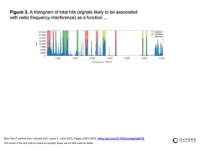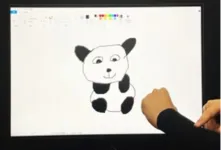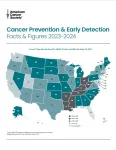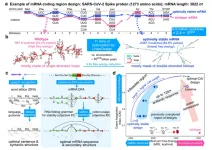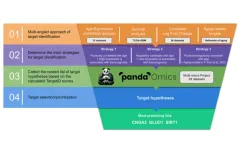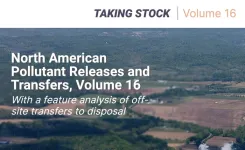(Press-News.org) May 2, 2023, Mountain View, CA, Manchester, UK and Mauritius -- What would the Earth look like to an alien civilization located light years away? A team of researchers from Mauritius and Manchester University has used crowd-sourced data to simulate radio leakage from mobile towers and predict what an alien civilization might detect from various nearby stars, including Barnard's star, six light years away from Earth. Ramiro Saide, currently an intern at the SETI Institute's Hat Creek Radio Observatory and M.Phils. student at the University of Mauritius, generated models displaying the radio power that these civilizations would receive as the Earth rotates and the towers rise and set. Saide believes that unless an alien civilization is much more advanced than ours, they would have difficulty detecting the current levels of mobile tower radio leakage from Earth. However, the team suggests that some technical civilizations are likely to have much more sensitive receiving systems than we do, and the detectability of our mobile systems will increase substantially as we move to much more powerful broadband systems.
Saide is also excited by the fact that his simulations show that the Earth’s mobile radio signature includes a substantial contribution from developing countries, including Africa. According to team leader Professor Mike Garrett (University of Manchester, Jodrell Bank Centre for Astrophysics), “the results highlight Africa’s success in bypassing the landline stage of development and moving directly into the digital age.” Garrett is pleased with the results. “I’ve heard many colleagues suggest that the Earth has become increasingly radio quiet in recent years - a claim that I always contested - although it’s true we have fewer powerful TV and radio transmitters today, the proliferation of mobile communication systems around the world is profound. While each system represents relatively low radio powers individually, the integrated spectrum of billions of these devices is substantial.”
Dr. Nalini Heeralall-Issur, Saide’s supervisor in Mauritius, thinks Saide might be right. “Every day we learn more about the characteristics of exoplanets via space missions like Kepler and TESS, with further insights from the JWST – I believe that there’s every chance advanced civilizations are out there, and some may be capable of observing the human-made radio leakage coming from planet Earth.”
The team is eager to extend their research to include other contributors to the Earth’s radio leakage signature. The next step is to include powerful civilian and military radars, new digital broadcast systems, Wi-Fi networks, individual mobile handsets and the swarm of satellite constellations now being launched into low Earth orbit, such as Elon Musk’s Starlink system. According to Garrett, “Current estimates suggest we will have more than one hundred thousand satellites in low Earth orbit and beyond before the end of the decade. The Earth is already anomalously bright in the radio part of the spectrum; if the trend continues, we could become readily detectable by any advanced civilization with the right technology.”
"This work is a superb example of how a detailed analysis of the properties of human technology (the “anthropogenic technosphere”) can be leveraged toward developing exciting, novel strategies for detecting extraterrestrial technologies,” said Allen Telescope Array Project Scientist Dr. Wael Farah. "We look forward to using the unique instrumentation capabilities and scheduling flexibility of the Allen Telescope Array, paired with our growing knowledge of nearby exoplanet systems, to undertake new searches based on these strategies.”
The paper has been accepted by MNRAS: https://academic.oup.com/mnras/article/522/2/2393/7028804
The paper is also available on the arXiv: https://arxiv.org/abs/2304.13779
Saide’s M.Phil research has been funded by the Development in Africa with Radio Astronomy (DARA) Project: www.dara-project.org
About the SETI Institute
Founded in 1984, the SETI Institute is a non-profit, multi-disciplinary research and education organization whose mission is to lead humanity’s quest to understand the origins and prevalence of life and intelligence in the Universe and to share that knowledge with the world. Its research encompasses the physical and biological sciences and leverages expertise in data analytics, machine learning and advanced signal detection technologies. The SETI Institute is a distinguished research partner for industry, academia and government agencies, including NASA and NSF.
Contact information
Rebecca McDonald
Director of Communications
SETI Institute
rmcdonald@seti.org
END
Can ET detect us?
What would the Earth look like to an alien civilization located light years away?
2023-05-02
ELSE PRESS RELEASES FROM THIS DATE:
UCSF is first in California to provide drug-gene testing
2023-05-02
Precision Medicine Milestone Will Result in Smarter Prescribing
Beginning May 9, UC San Francisco will be the first hospital in California, and one of only a few nationwide, to offer pharmacogenetic testing. The test will provide critical clues about a patient’s unique genetic makeup, enabling pharmacists to tailor medications and dosages accordingly.
The service will result in smarter prescribing and improved clinical outcomes, said Bani Tamraz, PharmD, PhD, associate professor in the Department of Clinical Pharmacy at the UCSF School of Pharmacy and lead of the pharmacogenomics program. A patient’s blood will be tested for 15 genes ...
A touch-responsive fabric armband – for flexible keyboards, wearable sketchpads
2023-05-02
It's time to roll up your sleeves for the next advance in wearable technology – a fabric armband that’s actually a touch pad. In ACS Nano, researchers say they have devised a way to make playing video games, sketching cartoons and signing documents easier. Their proof-of-concept silk armband turns a person’s forearm into a keyboard or sketchpad. The three-layer, touch-responsive material interprets what a user draws or types and converts it into images on a computer.
Computer trackpads and electronic signature-capture ...
New ACS report finds smoking rates, alcohol use, physical inactivity decreased during COVID-19; worsening trends in obesity, cervical cancer screening
2023-05-02
ATLANTA, May 2, 2023 – In a new report, American Cancer Society (ACS) researchers discovered both favorable and unfavorable changes in major cancer risk factors, preventive behaviors and services, and screenings in the United States during the COVID-19 pandemic. Between 2019 and 2021, current smoking, physical inactivity, and heavy alcohol consumption declined, and human papillomavirus vaccination and stool testing for colorectal cancer screening uptake increased. In contrast, obesity prevalence increased, while cervical cancer screening declined during the same timeframe. Additionally, disparities by racial/ethnic and socioeconomic status persisted.
The findings were released ...
New AI algorithm boosts COVID-19 mRNA vaccine antibody response by 128 times
2023-05-02
A team of researchers from Baidu Research has developed an AI algorithm that can rapidly design highly stable COVID-19 mRNA vaccine sequences that were previously unattainable. The algorithm, named LinearDesign, represents a major leap in both stability and efficacy for vaccine sequences, achieving a 128-fold increase in the COVID-19 vaccine’s antibody response.
“This research can apply mRNA medicine encoding to a wider range of therapeutic proteins, such as monoclonal antibodies and anti-cancer drugs, promising broad applications and far-reaching impact,” said Dr. He Zhang, Staff Software Engineer ...
RIPE researchers model ‘link’ between improved photosynthesis and increased yield
2023-05-02
A team from the University of Illinois has modeled improving photosynthesis through enzyme modification and simulated soybean growth with realistic climate conditions, determining to what extent the improvements in photosynthesis could result in increased yields.
“There’s a complex relationship between photosynthesis improvement and actual yield, having higher photosynthesis doesn’t necessarily mean you have higher yield. The yield return is highly impacted by seasonal climate conditions” said Yufeng He, a postdoctoral researcher at Illinois, who led this work for a research project called Realizing Increased ...
Dual-purpose therapeutic targets for aging and glioblastoma identified with PandaOmics
2023-05-02
“[...] AI-powered algorithms, such as PandaOmics, may accelerate subsequent gene target discovery not only for GBM but for a broader range of age-associated diseases.”
BUFFALO, NY- May 2, 2023 – A new research paper was published in Aging (listed by MEDLINE/PubMed as "Aging (Albany NY)" and "Aging-US" by Web of Science) Volume 15, Issue 8, entitled, “Identification of dual-purpose therapeutic targets implicated in aging and glioblastoma multiforme using PandaOmics - an AI-enabled biological target discovery platform.”
Glioblastoma Multiforme (GBM) is the most aggressive and most ...
Flagship report of the North American Commission for Environmental Cooperation, Taking Stock, examines where 5 billion kg of industrial pollutants go every year in North America
2023-05-02
Montreal — The North American Commission for Environmental Cooperation (CEC) today released a new report compiling and analyzing data reported by approximately 24,000 industrial facilities in Canada, Mexico and the United States to their respective national pollutant release and transfer registers. The report reveals important gaps in the reporting and tracking of transfers to disposal across the region due to differing reporting requirements, shared responsibilities across agencies and jurisdictions, and the lack of information about the fate of waste pollutants when they are transferred to third parties (such as waste management service providers) or across national ...
Cedars-Sinai Cancer appoints new biobank director
2023-05-02
Cedars-Sinai Cancer welcomes Karine Sargsyan, MD, formerly director of one of the world’s largest clinical biobanks, as scientific director of its OncoBiobank. Sargsyan is charged with leading biobank development and creating new strategies for the optimal deployment and use of the Cedars-Sinai Cancer Molecular Twin Precision Oncology Platform for both research and clinical practice. She will work collaboratively with Nicholas Tatonetti, PhD, associate director of Computational Oncology, on the ...
Upcycling method turns textile trash to functional coatings
2023-05-02
ITHACA, N.Y. - In an effort to make textiles more sustainable, a new method allows researchers to break old clothing down chemically and reuse polyester compounds to create fire resistant, anti-bacterial or wrinkle-free coatings that could then be applied to clothes and fabrics.
The proof-of-principle study provides hope for unsustainable textile, apparel and footwear industries that together generate 20% of global solid waste. Many so-called recyclers end up illegally dumping textiles as trash in countries in Asia and Africa.
“We think that our clothes are recycled or reprocessed, but most ...
Joyful music could be a game changer for virtual reality headaches
2023-05-02
Joyful music could be a game changer for virtual reality headaches
Listening to music could reduce the dizziness, nausea and headaches virtual reality users might experience after using digital devices, research suggests.
Cybersickness – a type of motion sickness from virtual reality experiences such as computer games – significantly reduces when joyful music is part of the immersive experience, the study found.
The intensity of the nausea-related symptoms of cybersickness was also found to substantially decrease with both joyful and calming music.
Researchers from the University of Edinburgh assessed the effects of music ...
LAST 30 PRESS RELEASES:
URI researchers uncover molecular mechanisms behind speciation in corals
Chitin based carbon aerogel offers a cleaner way to store thermal energy
Tracing hidden sources of nitrate pollution in rapidly changing rural urban landscapes
Viruses on plastic pollution may quietly accelerate the spread of antibiotic resistance
Three UH Rainbow Babies & Children’s faculty elected to prestigious American Pediatric Society
Tunnel resilience models unveiled to aid post-earthquake recovery
Satellite communication systems: the future of 5G/6G connectivity
Space computing power networks: a new frontier for satellite technologies
Experiments advance potential of protein that makes hydrogen sulfide as a therapeutic target for Alzheimer’s disease
Examining private equity’s role in fertility care
Current Molecular Pharmacology achieves a landmark: real-time CiteScore advances to 7.2
Skeletal muscle epigenetic clocks developed using postmortem tissue from an Asian population
Estimating unemployment rates with social media data
Climate policies can backfire by eroding “green” values, study finds
Too much screen time too soon? A*STAR study links infant screen exposure to brain changes and teen anxiety
Global psychiatry mourns Professor Dan Stein, visionary who transformed mental health science across Africa and beyond
KIST develops eco-friendly palladium recovery technology to safeguard resource security
Statins significantly reduce mortality risk for adults with diabetes, regardless of cardiovascular risk
Brain immune cells may drive more damage in females than males with Alzheimer’s
Evidence-based recommendations empower clinicians to manage epilepsy in pregnancy
Fungus turns bark beetles’ defenses against them
There are new antivirals being tested for herpesviruses. Scientists now know how they work
CDI scientist, colleagues author review of global burden of fungus Candida auris
How does stroke influence speech comprehension?
B cells transiently unlock their plasticity, risking lymphoma development
Advanced AI dodel predicts spoken language outcomes in deaf children after cochlear implants
Multimodal imaging-based cerebral blood flow prediction model development in simulated microgravity
Accelerated streaming subgraph matching framework is faster, more robust, and scalable
Gestational diabetes rose every year in the US since 2016
OHSU researchers find breast cancer drug boosts leukemia treatment
[Press-News.org] Can ET detect us?What would the Earth look like to an alien civilization located light years away?
